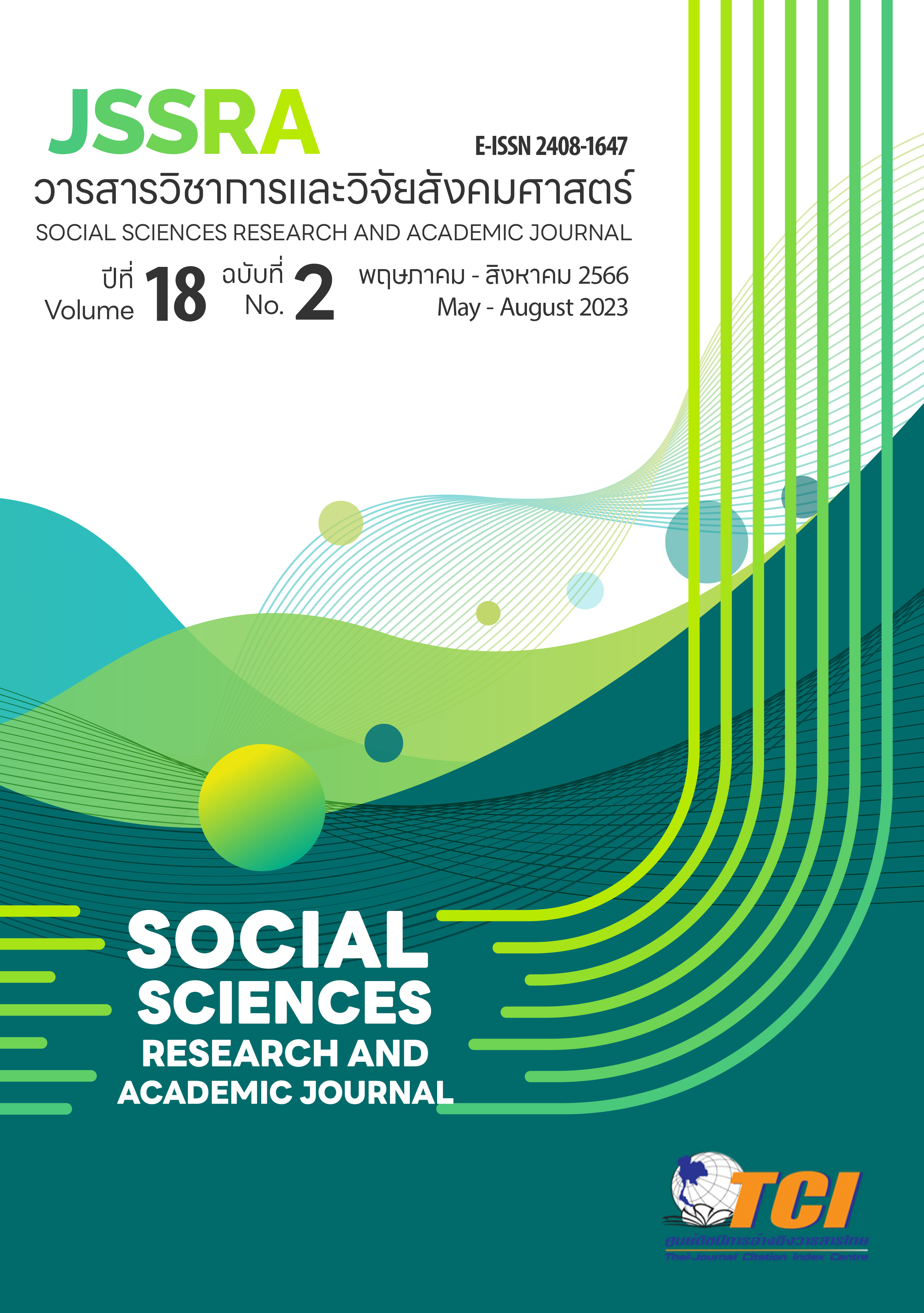ปัจจัยที่มีอิทธิพลต่อความตั้งใจซื้อสินค้าเพื่อสิ่งแวดล้อม กลุ่มเครื่องสำอางและบำรุงผิว Factors Influencing Green Purchase Intention of the Cosmetic and Skin Care Product
Main Article Content
บทคัดย่อ
งานวิจัยนี้มีวัตถุประสงค์เพื่อศึกษาอิทธิพลของการรับรู้ความรับผิดชอบต่อสังคม การรับรู้คุณภาพสินค้าเพื่อสิ่งแวดล้อม และความไว้วางใจต่อสินค้าเพื่อสิ่งแวดล้อมที่มีต่อความตั้งใจซื้อสินค้าเพื่อสิ่งแวดล้อมกลุ่มเครื่องสำอางและบำรุงผิว โดยการวิจัยเชิงปริมาณนี้ใช้แบบสอบถามรวบรวมข้อมูลจากกลุ่มตัวอย่างซึ่งเป็นผู้บริโภคที่เคยใช้สินค้าเพื่อสิ่งแวดล้อมกลุ่มเครื่องสำอางและบำรุงผิว จำนวน 328 คน เครื่องมือที่ใช้ คือ แบบสอบถาม สถิติที่ใช้ในการวิเคราะห์ข้อมูล ได้แก่ การวิเคราะห์เชิงพรรณนา และการวิเคราะห์แบบจำลองสมการโครงสร้าง
ผลการวิจัยพบว่า ระดับความคิดเห็นของผู้ตอบแบบสอบถามต่อปัจจัยการรับรู้ความรับผิดชอบต่อสังคมในภาพรวม (X̅ = 3.92) การรับรู้คุณภาพสินค้าเพื่อสิ่งแวดล้อม (X̅= 4.03) ความไว้วางใจต่อสินค้าเพื่อสิ่งแวดล้อม (X̅= 3.96) และความตั้งใจซื้อสินค้าเพื่อสิ่งแวดล้อม (X̅= 4.09) ผลการวิเคราะห์ขนาดอิทธิพล พบว่า ปัจจัยการรับรู้คุณภาพสินค้าเพื่อสิ่งแวดล้อมและความไว้วางใจต่อสินค้าเพื่อสิ่งแวดล้อมมีอิทธิพลทางตรงต่อความตั้งใจซื้อสินค้าเพื่อสิ่งแวดล้อม มีค่าเท่ากับ .244 และ .714 ปัจจัยการรับรู้ความรับผิดชอบต่อสังคมและการรับรู้คุณภาพสินค้าเพื่อสิ่งแวดล้อมมีอิทธิพลทางตรงต่อความไว้วางใจต่อสินค้าเพื่อสิ่งแวดล้อม มีค่าเท่ากับ .389 และ .511 ผลที่ได้จากการวิจัยนี้เป็นแนวทางสำหรับผู้ผลิตและผู้จัดจำหน่ายสินค้าเพื่อสิ่งแวดล้อมในการให้ความสำคัญกับการสื่อสารทางการตลาดด้วยการให้ข้อมูลที่เป็นความจริงและน่าสนใจเกี่ยวกับคุณภาพสินค้า รวมถึงประโยชน์ด้านสิ่งแวดล้อมที่ผู้บริโภคจะได้รับ ซึ่งเป็นการแสดงถึงลักษณะและภาพลักษณ์สินค้าเพื่อสิ่งแวดล้อมอันจะส่งผลต่อความพึงพอใจและไว้วางใจของผู้บริโภคให้ดียิ่งขึ้น
Article Details
References
Aaker, D. A. (1991). Managing Brand Equity: Capitalizing on the Value of a Brand Name. New York: The Free Press.
Ahn, J., & Kwon, J. (2020). “CSR perception and revisit intention: the roles of trust and commitment”. Journal of Hospitality and Tourism Insights. 3(5): 607-623.
Ali, R., Munandar, J. M., & Syamsun, M. (2019). “The Effect of Green Perceived Quality, Green Perceived Value, Green Perceived Risk, Green Satisfaction and Green Trust in Stimulating Green Brand Equity Starbucks, West Java”. International Journal of Research & Review. 6(2): 74-78.
Carroll, A. B. (1991). “The pyramid of corporate social responsibility: Toward the moral management of organizational stakeholders”. Business Horizons. 34(4): 39-48.
Carroll, B.A. and Ahuvia, A. (2006). “Some antecedents and outcomes of brand love”. Marketing Letters. 17(2): 79-89.
Chen, Y. S., & Chang, C. H. (2012). “Enhance green purchase intentions. The roles of green perceived value, green perceived risk, and green trust”. Management Decision. 50(3): 502-520.
Chen, Y. S., & Chang, C. H. (2013). “Towards green trust: The influences of green perceived quality, green perceived risk, and green satisfaction”. Management Decision. 51(1): 63 – 82.
Chen, Y. S., Lin, C. Y., & Weng, C. S. (2015). “The influence of environmental friendliness on green trust: The mediation effects of green satisfaction and green perceived quality”. Sustainability. 7(8), 10135-10152.
Chen, Y.-S. (2010). “The drivers of green brand equity: green brand image, green satisfaction, and green trust”. Journal of Business Ethics. 93(2): 307-19.
Cheung, R., Lam, A. Y., & Lau, M. M. (2015). “Drivers of green product adoption: the role of green perceived value, green trust and perceived quality”. Journal of Global Scholars of Marketing Science. 25(3): 232-245.
Chuah, S. H. W., El-Manstrly, D., Tseng, M. L., & Ramayah, T. (2020). “Sustaining customer engagement behavior through corporate social responsibility: The roles of environmental concern and green trust”. Journal of Cleaner Production. 262(2020): 121348.
Duc, B.H., & Do Ba, K. (2017). Business responses to climate change: strategies for reducing greenhouse gas emissions in Vietnam. Asia-Pacific Business Review, 23(4), 1-2.
Fornell, C., & Larcker, D.F. (1981). “Evaluating Structural Equation Models with Unobservable Variables and Measurement Error”. Journal of Marketing Research. 18(1): 39-50.
Hair, J. F., Black, W. C., Babin, B. J., & Anderson, R. E., (2010). Multivariate data analysis: A global perspectives. Upper Saddle River, NJ: Pearson Education, International.
Hart, P. & Saunders, C. (1997). “Power and trust: Critical factors in the adoption and use of electronic data interchange”. Organizational Science. 8(1): 23-42.
Kotler, P., & Keller, K.L. (2016). Marketing management. Kendallville: Pearson Education.
Lee, Y. H., & Chen, S. L. (2019). “Effect of green attributes transparency on wta for green cosmetics: Mediating effects of CSR and green brand concepts”. Sustainability. 11(19): 5258.
Nguyen, T. T. H., Yang, Z., Nguyen, N., Johnson, L. W., & Cao, T. K. (2019). “Greenwash and green purchase intention: The mediating role of green skepticism”. Sustainability (Switzerland). 11(9): 1-16.
Paul, J., Modi, A., & Patel, J. (2016). “Predicting green product consumption using theory of planned behavior and reasoned action”. Journal of Retailing and Consumer Services. 29(2016): 123-134.
Saleem, A., Ghafar, A., Ibrahim, M., Yousuf, M., & Ahmed, N. (2015). “Product perceived quality and purchase intention with consumer satisfaction”. Global journal of management and business research. 15(1).
Srisathitnarakul, B. (2012). Development and Quality Inspection Research Tools: Psychological Measurement Features. Bangkok: Chulalongkorn University Printing Company.
Svensson, G. & Wagner, B. (2012). “Business sustainability and E-footprints on Earths life and ecosystems: Generic models”. European Business Review. 24(6): 543-552.
Tarabieh, S. M. Z. A. (2021). “The impact of greenwash practices over green purchase intention: The mediating effects of green confusion, Green perceived risk, and green trust”. Management Science Letters. 11(2): 451-464.
The United Nations in Thailand. (2015). Goals from MDGs to SDGs. https://www.un.or.th/glo. 1 March 2021.
Thi, Q., & Van, P. L. (2016). “Consumers' perception towards corporate social responsibility and repurchase intention: A study of consumer industry in Vietnam”. Industrial Engineering and Management Systems. 15(2): 173-180.

